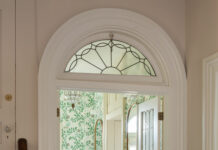Palatial. Unique. Labyrinthian. In many ways, the estate on the Severn River renovated by architect Charles Anthony and interior designer Henry Johnson defies description. The size and scope of the project is beyond the imagination of most. The attention to detail and emphasis on proportions and craftsmanship are unparalleled. Yet the house is also unpretentious, warm and highly personal, the result of a longtime partnership between the homeowners and a dedicated team of professionals.
The modifications made by the current owners carry on a long tradition of change on the property. Built in the early 20th century, the house is a five-part Georgian that mirrors the architecture of the grand James River plantations of Carter’s Grove and Westover. In the 1940s the house was purchased by the Catholic Church and turned into a friary, complete with a five-story dormitory for the monks’ cells, a full cafeteria with commercial kitchen and a chapel. Anthony, based in Annapolis, first encountered the project when prior owners were considering a renovation, but decided against such a massive undertaking.
Not so the present owners, who gutted much of the interior and modified the exterior structure in keeping with the home’s classical proportions. “They weren’t interested in strict historic preservation, but rather adapting all this beautiful space to their needs,” says Anthony. Of particular interest to the homeowners was letting more light into the house and expanding the views to the outdoors. Anthony made the windows larger, added dormers and extended a colonnade at the front door.
More dramatic was the transformation at the rear of the house where the monk’s dormitory was torn down and its footprint reused to create a terrace, pool pavilion and infinity pool (with garage below). The chapel, which has the appearance of a medieval great hall, was preserved, and a spa and indoor pool were placed below it. Yet something needed to pull these wings together. “At the intersection of the five-part Georgian and the wings became the rotunda,” Anthony explains. “It’s literally a hub around which these other elements of the house are connected.”
It is this area that, if pressed for a favorite space in the house, Johnson would probably name. So too would Matthew Mosca, the historic paint finishes consultant who worked with Johnson on the home’s interior color scheme and architectural detailing.
“I would run a person over for one of the teak columns,” quips Johnson, alluding to the eight 12-foot columns that support the conservatory area of the rotunda structure. It is a matter of great pride for Johnson and Mosca that they persuaded the homeowners not to stain or varnish the columns, but to leave them in their primitive, architectural state. The room itself is elemental and sparse, featuring the columns (hand-hewn in India), a hand-cut limestone floor and two Chinese scribe chairs.
“It’s a very powerful space because there’s little there, yet it’s extremely elegant,” says Mosca. Extreme elegance with a nod toward a certain level of restraint marks the entire interior design of the home, which does not go in for McMansion stereotypes of design, where every inch of structure is stuffed with furniture with matching trims. The rooms are large and, relatively, few in number. “It’s amazing for what it’s not,” says Johnson. “It’s such an unpretentious home. It’s very cozy, even though it’s big. It’s all a matter of line and proportion.”
Although the house was completely renovated, efforts were made to preserve certain priceless elements, like the original pine floors, the moulding on the foyer arch and the dining room’s plaster ceiling and mantel. However, the house is not a slave to history, but rather takes cues from the historic past. For example, Mosca selected the paint palette used throughout the house (creamy yellows and blue-greens) based on the traditional hand-painted silk wall covering used in the dining room. In the gentleman’s dressing room, a classic fireplace moulding and restrained paneling is rendered in teak for a modern twist.
The homeowner has access to materials from around the world through business connections, particularly in the Pacific Rim. The house is resplendent with exotic woods such as mahogany and teak from India and Thailand. Johnson recalls how ships loaded with marble arrived from India and the project “used enough limestone to rebuild the Capitol.” In addition, the owner has a “warehouse” full of collectibles and furniture from the Far East that inform the interior design.
“The large, open spaces allowed us a lot of freedom to put back properly scaled crown mouldings, mantels and window and door frames, and gave us the opportunity to give [the owners] a background for their collection of furniture, art and objects of delight accumulated in world travels,” says Johnson. Items not selected from the homeowners’ existing collection were custom designed by Johnson and much of the furniture was fabricated in Baltimore.
The house doesn’t have a straightforward “living room,” but rather a series of comfortable entertaining spaces, each with its own personality. In the library, mahogany and American oak are paired with a tooled leather ceiling and 18th-century brass chandeliers. In what is known as the “print room,” striped silk upholstered walls complement furniture covered in a fabric replicated from the French court of the 18th century. Although its provenance is grand, the natural elements in the fabric make it feel like it belongs in a country home.
The home is designed to look as though it has evolved over time, says Mosca. “The first floor of the principal house is, in terms of the architectural detailing, almost entirely 18th-century,” he explains. “We did the second floor as if it was redone in the Greek Revival era, using different moulding profiles in the bedroom suite… It all flows really well, so there’s nothing jarring about going from one place to the next.”
The couple’s bedroom relies heavily on the Greek Revival style in its mouldings (based on designs by Asher Benjamin) and exemplifies the rich simplicity of the yellow and green color scheme. “She wanted the room to be very soft and serene,” says Johnson of the wife. European antiques co-exist pleasantly with Asian accents such as the Oriental rain drum used as a coffee table in the bedroom’s sitting area. It begs pointing out that the rug is the same as that selected by Michelle Obama for her bedroom in the White House.
The Greek Revival style was chosen in part because it worked well with the Art Deco appearance the wife wanted for her personal bath suite. Both husband and wife have their own private bathing suites that encompass their unique styles. Hers is uniquely feminine with a touch of old Hollywood glam, featuring a marble tub, crystal chandelier from England, enormous mirrors and custom-designed, platinum-leafed furniture that gives the suite a glimmering patina.
His is more muscular and reflects his love of the Orient, though the most unique feature actually came from Europe. The bathroom suite judiciously showcases stained-glass windows and doors— flanking his sink, for example, and his closet doors— which are 19th-century Scottish in origin, but were purchased by the owner while in Asia.
If the project itself is unique, it is perhaps a reflection on the owners. “I’ve never worked with clients like this before,” says Anthony. “This was a mammoth, complex project and they were really engaged in all of it and interested and had great ideas for much of what went on.”
Johnson and Mosca concur, noting how not a single nailhead or floorboard went into the house without the owner’s scrutiny. “Meetings with the client were like classes in architectural history,” says Johnson, recalling the intense collaboration, education and research that went into the project. That is one reason it took six years to complete, and is still evolving. He adds, “This is the closest thing to a handmade, grand home that I know of.”




